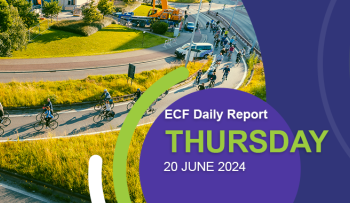
Day 03 at Velo-city 2017 [15th June]
Day 02 Highlights here!
Freedom of Children
The motto of Velo-city 2017 is ‘The Freedom of Cycling’ and for children around the world the bicycle does indeed represent freedom. However, the environment that children grow up inevitably effects the way that they use their bikes. The session Freedom for Children brought together three speakers presenting very different conditions around the world and explained what the freedom of cycling means for both the children living there and their parents.
 Some studies show that Dutch children are the happiest on earth. Could this have something to do with the freedom they have while cycling? Writer Marieke Dubbelman is a mum of four children certainly believes so. She lives in a typical Dutch suburb in Utrecht surrounded by excellent cycling infrastructure. In her presentation she gave an overview of a standard day in the life of her family. The bicycle played a key role for all family members – whether it was travelling to work, school, football practice or just visiting the local fast food restaurant with their friends. Her advice was to be an example for your children (especially when it rains!), to trust your child in every step and to remember that freedom for children is also freedom for parents too (you no longer have to act as a taxi driver!)
Some studies show that Dutch children are the happiest on earth. Could this have something to do with the freedom they have while cycling? Writer Marieke Dubbelman is a mum of four children certainly believes so. She lives in a typical Dutch suburb in Utrecht surrounded by excellent cycling infrastructure. In her presentation she gave an overview of a standard day in the life of her family. The bicycle played a key role for all family members – whether it was travelling to work, school, football practice or just visiting the local fast food restaurant with their friends. Her advice was to be an example for your children (especially when it rains!), to trust your child in every step and to remember that freedom for children is also freedom for parents too (you no longer have to act as a taxi driver!)
Paul Robison from the UK explained how British children have to learn how to cycle in slightly more challenging conditions in comparison with the Netherlands. For the last eight years, Paul has been steering Bikeability, the national cycle training scheme in the UK where children do not have the benefit of the cycling infrastructure that Marieke’s family enjoy. The Bikeability programme therefore aims to give children their passport to freedom by teaching them how to cycle with confidence on the road. The scheme has been successful with over 50% of children cycle more after receiving Bikeability training but he admits that there is still much more that can be done.
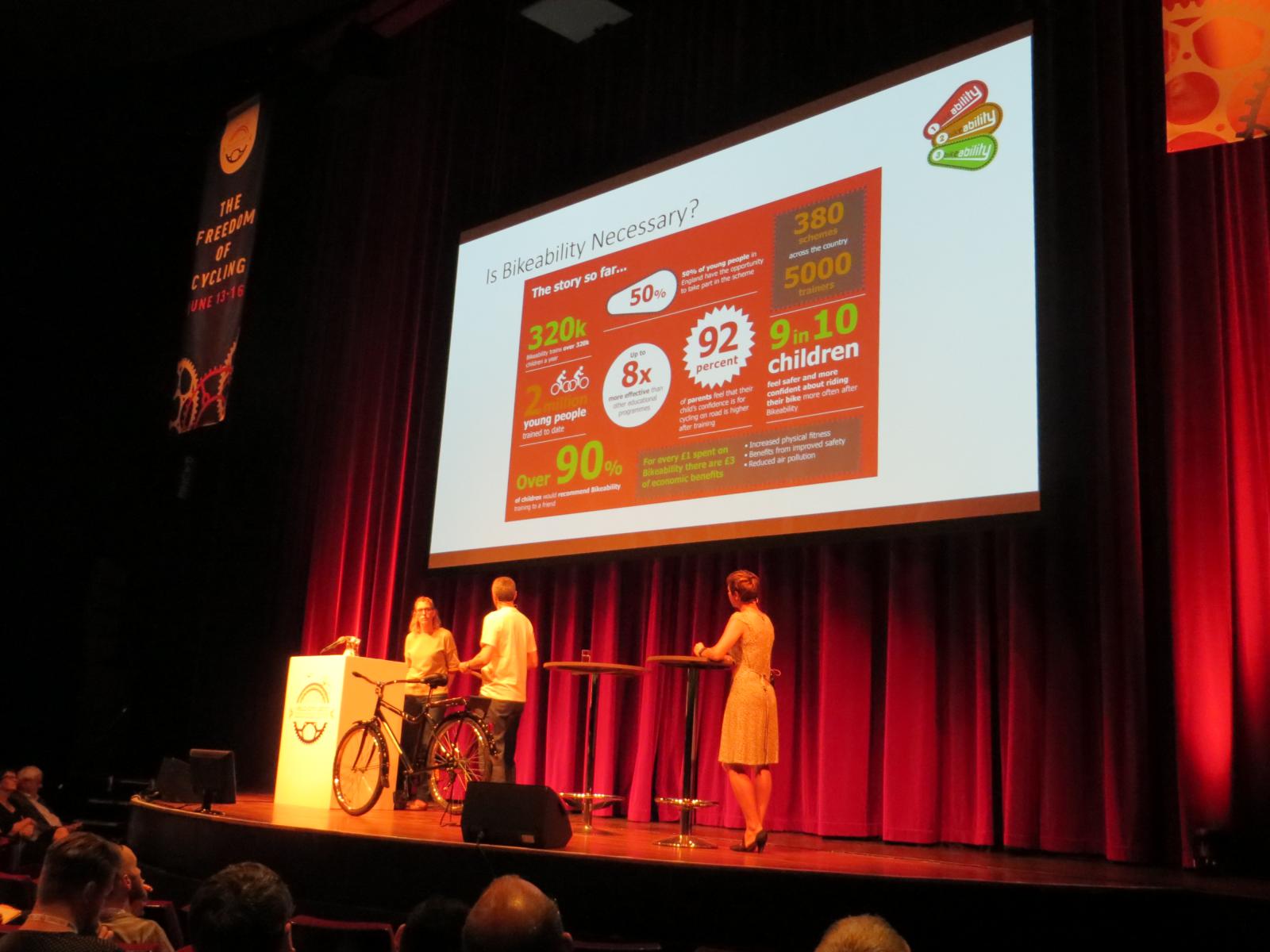
The final presentation was given by Kristina Jasiunaite from World Bicycle Relief, the German organisation that distributes bicycles to children in developing countries. Kristina began by pointing out that freedom starts when basic needs are fulfilled. As walking is the primary mode of transportation for many people in the developing world lots of time is spent on travelling to fulfil these basic needs (e.g. collecting water, buying food etc.). Providing bicycles can therefore allow children to spend less time travelling more time on experiencing freedom, which for many includes attending school. To date World Bicycle Relief have distributed 350,000 bicycles around the world, which is some areas has led to enrolment in schools increasing by 30%.
At the end of the session there was a surprise announcement when Saskia Kluit, Director of Fietsersbond, announced that to recognise just how special the conditions are in the Netherlands for children to experience freedom by bike, an application will be submitted for it to be added to the UNESCO’s list of Intangible Cultural Heritage. Furthermore, the Dutch artist Onno van Dockum will be designing a national monument to the cycling schoolchild!
Written by: Ed Lancaster, Senior Policy Officer – Cycling Tourism and Regional Policy
Outdoor Study Visit of Nijmegen’s (Wonderful!) Cycle Parking System
The most popular parts of Velo-city are often the study visits. On Day 2, this was again the case: delegates were in awe of Nijmegen’s cycle parking system and facilities!
In response to the huge numbers of residents and visitors using bicycles, the City of Nijmegen has put a lot of thought, effort and money into creating a world class cycle parking system. On the one hand this comprises an array of high quality underground cycle parking facilities at important destinations, while on the other hand it includes carefully considered procedures to deal with poorly parked bicycles on city streets.
The two high-capacity cycle parking facilities at Nijmegen Central Station accommodate approx. 5000 bicycles between them – one is free while the other (completely underground) facility charges a small fee, payable on a weekly, monthly or yearly basis. The nearby ‘Sleeping Beauty’ concert hall and student accommodation building includes indoor space for 4000 bikes. One striking aspect of the design of this facility was the artist-created multi-coloured flooring so to make it easier for users to find their bikes – as well as making the building far funkier and more attractive! Study tour participants examined the different technologies that record when cycle stands are full or empty, and where cargo bikes and e-bikes are parked (and charged in the case of e-bikes). Chapeau Nijmegen Municipality!
The other dimension explored by tour participants was the parking enforcement system. The City wants to ensure that pedestrian conditions do not suffer from poorly parked bicycles; equally, some businesses in the central area prefer not to have very large numbers of randomly parked bicycles directly outside designated bicycle parking zones. In response, the City has created a systematic way of tagging bikes that are either parked outside of dedicated zones on particular streets – or are perhaps abandoned. It was great to hear the details of the system directly from the municipality employees working on the streets and those in the depots that store the bikes until they are reclaimed - or else moved on to a social enterprise where they are mended and resold or redistributed.
All in all, this was a neat and stimulating tour! There is no doubt that the very impressive systems that Nijmegen introduced are now inspiring other cities to do like-wise. Up the Velo-rution!!
Written by: Damien O'Tuama, ECF Vice-President
Innovation in Bikes and Smart Mobility Solutions (MAAS)
Three claims summarise this session on innovation in bikes and smart mobility solutions: Connectivity in general and connected bicycles in particular will have a positive impact on road safety and on user mobility choices; the bicycle industry will overtake the automotive industry in terms of innovations; technology alone will not solve all future cities problems.

Stefanie de Hair from the Dutch Research Institute TNO introduced to the audience the latest technological developments in improving road safety for people cycling. While the general focus until a few years ago was put on ‘injury mitigation’, for example through the development of a car windshield airbag, the attention has now moved to ‘injury prevention’, among other through Automated Emergency Braking Systems. With the advent of the connected bicycle thanks to the power supply of electric bicycles, the bicycle will be able to communicate to infrastructure and other vehicles leading to a ‘smoother intervention’ between different modes of transport, she predicted. Most workshop participants subscribed to her statement: “Technological innovation will have a positive impact on the safety of cyclists.”
Raymond Gense from Next Urban Mobility took de Hairs findings to claim that the bicycle industry will overtake the automotive industry in terms of innovations due to the long car product cycles of 4 to 8 years. The connected bicycle will also be able to become a full partner in Mobility as a Service Systems and herewith improve the usability side of mobility systems. Using the mode of transport that fits best the purpose of your trip, will characterise future mobility choices he predicted. A full integration would also help bike sharing systems to become profitable which is difficult at the moment if they are operating on their own, he added.
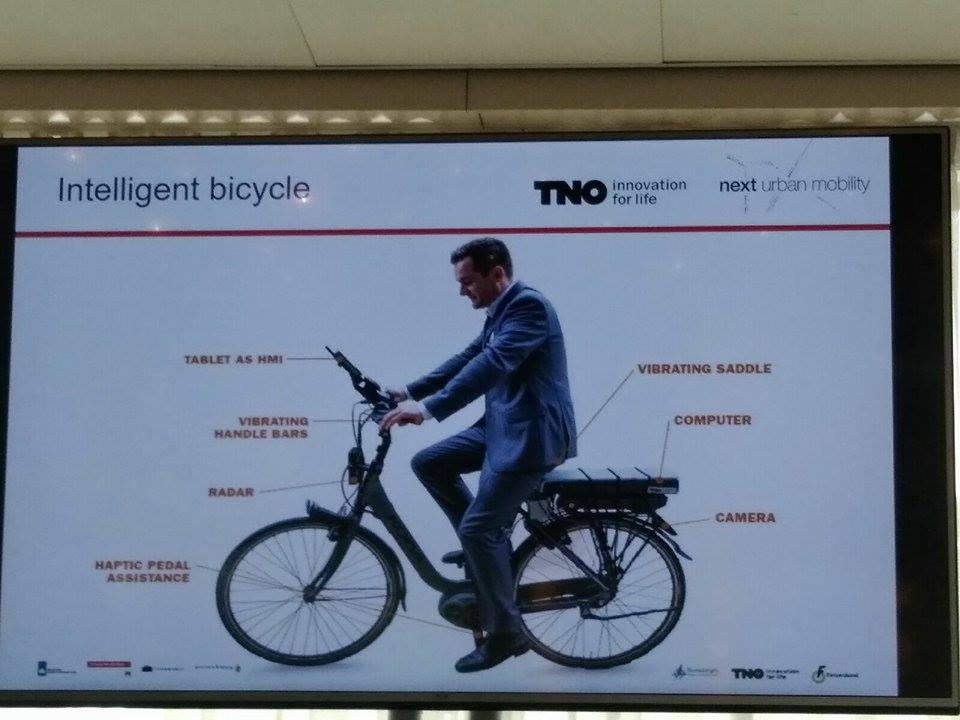 While a substantial part of this workshop subscribed to the statement: “In the city of the future the bicycle will be THE means of transportation”, not a single person raised its fingers when claimed: “Technology will solve all future cities problems.”
While a substantial part of this workshop subscribed to the statement: “In the city of the future the bicycle will be THE means of transportation”, not a single person raised its fingers when claimed: “Technology will solve all future cities problems.”
In fact, according to Gense, technology can also create problems. The development of the speed pedelec, he exemplatory said, is hampered by an inadequate legal framework, such as the use of moped helmets (meanwhile solved through the development of a specific s-pedelec helmet) or the prohibition to use cycle paths. Geo-fencing, he concluded, might solve this problem by making s-pedelecs comply with the given speed limit.
Written by: Fabian Kuester, Senior Policy Officer
Cycling Tourism: Stimulating Urban Cycling – Speed Date
The promotion of cycling is not always easy, especially not when faced with challenges such as missing cycle infrastructure or low bike ownership. The main focus of today’s speed date session was on how cycle tourism can help to start and grow urban cycling. Over 20 participants attended the interesting and inspiring speed date session in which speakers from three very diverse countries (Japan, Denmark and Italy), presented and exchanged their experiences and best practice examples on how cycle tourism can be used as a means to stimulate and advance urban cycling. Cycle tourism is a new alternative to traditional tourism in which the bicycle is the primary mode of transport. It enables tourists to discover appealing localities from a different perspective- from a bike.
 Haruhiko Yamasaki, from the Kokusai Kogyo Group, gave a short presentation on the cycle tourism project “Churashima Cycling” on the beautiful island of Okinawa- the southernmost prefecture of Japan. Okinawa has plenty of beautiful and appealing tourist attractions and an increasing amount of tourists discover its beautiful beaches and heritage sites on a bike. In order to enhance the bicycle use and cycle tourism in Okinawa even further, various efforts are made such as the creation of various types of maps, the establishment of rest stops for cyclists or the analysis of bicycle rental systems. In recent years, the number of bicycle users has increased rapidly in Okinawa, as a result of its successful bicycle tourism. Therefore, Okinawa and the Churashima Cycling project can serve as a role model for the rest of Japan.
Haruhiko Yamasaki, from the Kokusai Kogyo Group, gave a short presentation on the cycle tourism project “Churashima Cycling” on the beautiful island of Okinawa- the southernmost prefecture of Japan. Okinawa has plenty of beautiful and appealing tourist attractions and an increasing amount of tourists discover its beautiful beaches and heritage sites on a bike. In order to enhance the bicycle use and cycle tourism in Okinawa even further, various efforts are made such as the creation of various types of maps, the establishment of rest stops for cyclists or the analysis of bicycle rental systems. In recent years, the number of bicycle users has increased rapidly in Okinawa, as a result of its successful bicycle tourism. Therefore, Okinawa and the Churashima Cycling project can serve as a role model for the rest of Japan.
Jesper Pørksen, from the Danish non- profit association “Danish Cycling Tourism” gave a short overview on how minor roads in Denmark can be used as a means to increase cycle tourism and cycle use in general. According to Jesper “Cycling in certain Danish areas is decreasing, while at the same time cycling tourism is increasing in these areas”. A way to promote bicycle tourism in Denmark could be to move cars from minor roads to bigger roads to make more space for cyclists on minor roads. This would make the minor roads safer for cyclists and would thus lead to an increase of urban cycling.
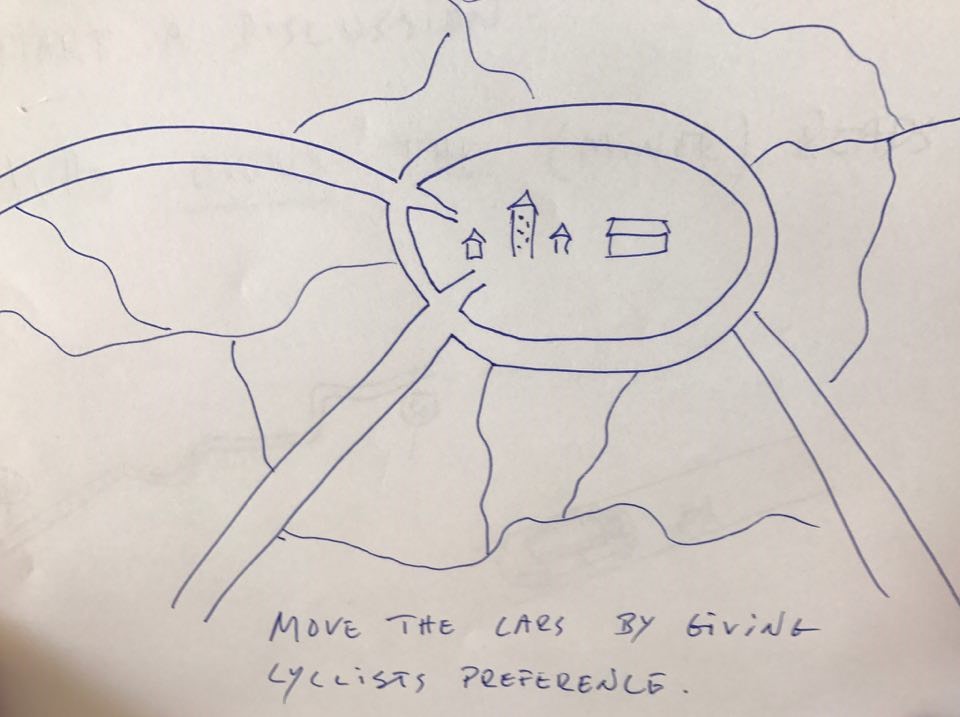 Veronica Zucca from Italy, presented a cycling mobility promotion programme, which intends to promote cycling mobility in all its forms, in particular for daily travel and urban contexts. In her presentation, she pointed out that in Sardinia, cycling is still viewed as either a recreational or sport activity rather than a means of transportation. In order to change the public opinion of the people in Sardinia, it is important to establish practical and safe routes for cyclists. The main rationale of the programme is that the promotion of cycling for leisure, tourism and sport might make people more aware of the fact that the bike can be used for daily trips along urban roads.
Veronica Zucca from Italy, presented a cycling mobility promotion programme, which intends to promote cycling mobility in all its forms, in particular for daily travel and urban contexts. In her presentation, she pointed out that in Sardinia, cycling is still viewed as either a recreational or sport activity rather than a means of transportation. In order to change the public opinion of the people in Sardinia, it is important to establish practical and safe routes for cyclists. The main rationale of the programme is that the promotion of cycling for leisure, tourism and sport might make people more aware of the fact that the bike can be used for daily trips along urban roads.
The speed date session provided 3 excellent best practice examples of what can be done to promote cycle tourism and to use it as a means to enhance urban cycling. The 20 participants who joined the speed date had very fruitful discussions in small groups, guided by the speakers and the moderator before moving to another table.
Who are the people that regularly use a bicycle and what are their needs? Which groups do not cycle and why not? Surveys from different countries demonstrate chances for raising bicycle use among different groups. Using bicycles entails a lot of benefits at individual level and for society in general. But not all people are cycling and significant differences can be detected within groups, introduced Ms Sarah Imm, moderator of the session.
People that cycle to work are happier and healthier than the ones commuting by car. That’s why the Province of Gelderland has developed a huge cycling highways’ network, explained Ms Anita Stienstra. People mostly cycle for joy but it was interesting to go more in details on how different groups cycle. Young people cycle because is cheap, other ages groups mostly for fun. Two studies show also that 61% of cyclists are male and 75% are people with high-level education. Surprisingly 92% of them has a driving license but they choose bike anyway. 50% cycle more than 18 km, 30% cycle 4 days per week or more, 34% 2-3 days per week. The most important result achieved is about the behavioural change achieved, said Ms Stienstra: 75% of people that tried to regularly cycle for the first time continues to do that.
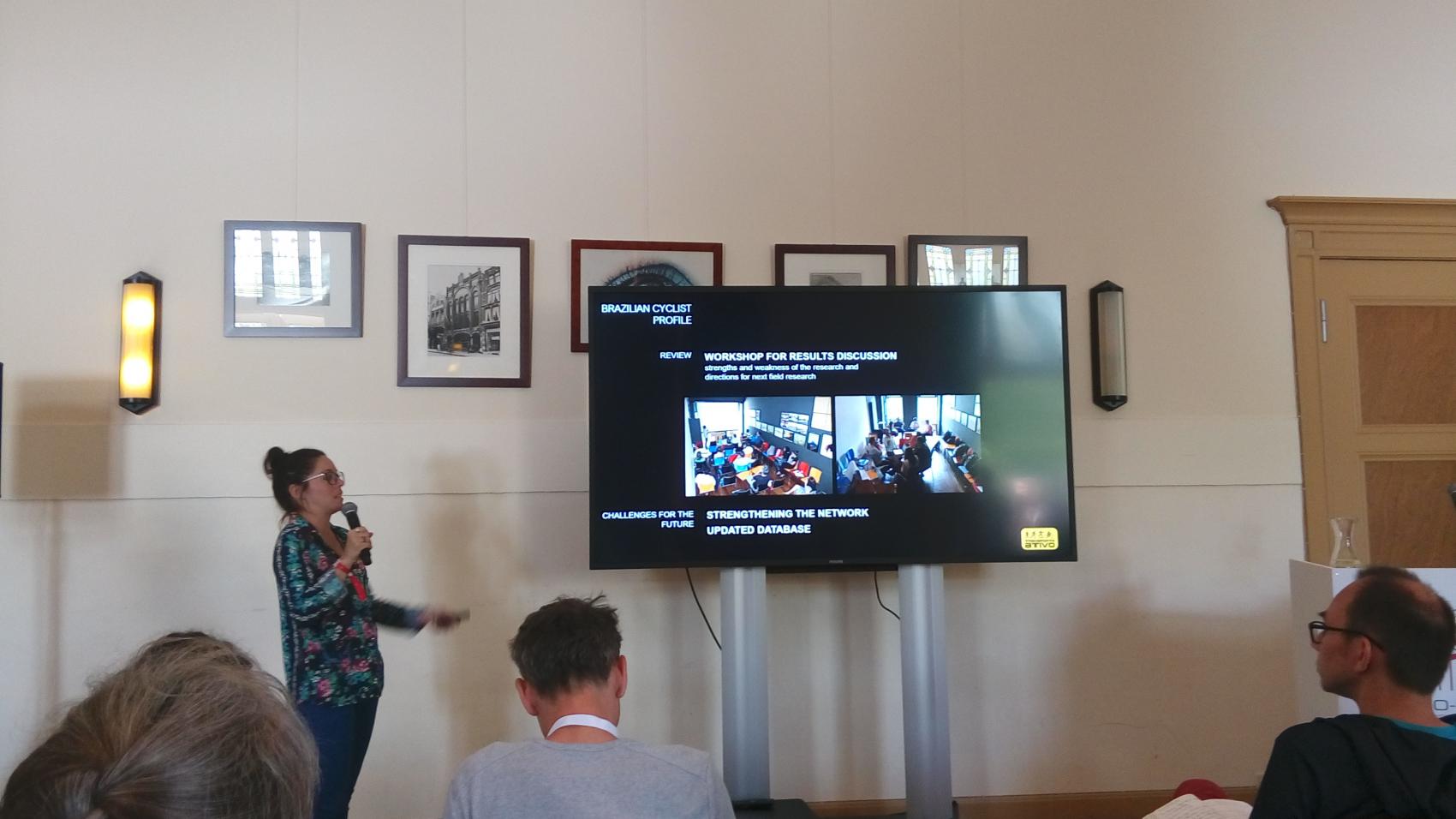 The session also gave participants the opportunity to have an overview on the profile of cyclists in two emerging countries: Brasil and India.
The session also gave participants the opportunity to have an overview on the profile of cyclists in two emerging countries: Brasil and India.
Transporto Ativo aims at encouraging people cycling more often. The organization, in joint cooperation with universities and local cyclists’ association undertook a research to gather some important data on people cycling in Brasil, Ms Gabriela Binatti explained. The consortium developed a methodology to circulate the survey among cyclists in the 10 involved cities. A second phase allowed the organizers to train people on how to approach interviewees and to collect data. Finally, the report was published. A glimpse on figures and findings: 5,012 interviewees declared to ride a bike at least once per week, 88% of them to get to the workplace or school. The main motivation is that cycling is faster than any other means of transport, concluded Ms Binatti.
Mr Shravan Shah, from the University of Amsterdam, showed interesting figures on the Indian situation. The first bike sharing scheme started in 2014. India has differences on cycling linked to social conditions: low-income people mainly cycle to work, while high-income groups for leisure. If we compare ownership data, India shows 0.09 bike per capita, the opposite of 1.10 bike per capita in the Netherlands. Also differences are related to gender issues: 99.9% of cyclists are male. Some main challenges are ahead: implementing financial schemes for cycling, reducing car dependency, improving infrastructures and having more technological products for cycling. Indians also think that infrastructures and their maintenance are necessary to improve and increase cycling, said Mr Shah.
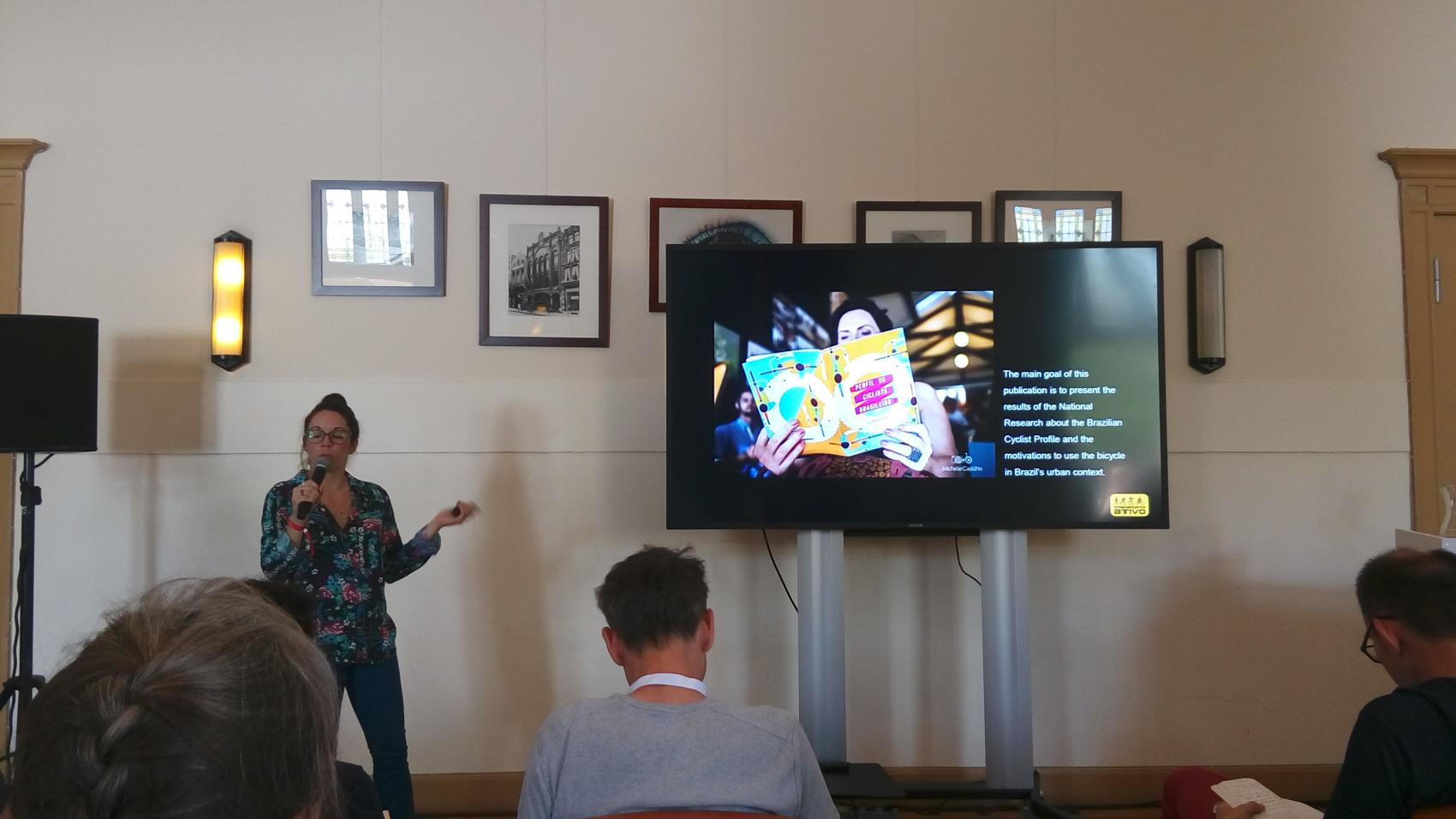
Coming back to Europe, Ms Sofie Walschap presented the profile of cyclists in Bruxelles through a research undertaken in 2016 and 2017. The Brussels Mobiliteit investigated why only 7% of the active population is cycling. The researched focused on parents and children in order to understand how the first can influence the behavior of the latter. 3 main factors are influencing people’s choice to cycle: individual, social and environmental. The survey was conducted on a target groups of children aged 12-18 yo, attending 4 secondary schools in neighborhoods with different social conditions. The findings put in evidence that young people has a wrong perception of cycling and cycling advantages. Most of them thinks that public transport is faster and cheaper than cycling. 88% of interviewees has parents who don’t cycle and 9% of them discourages their children to use the bike. Also, students believe that cycling is dangerous because the traffic jam and narrow paths. Brussels Mobiliteit will implementing behavioral change campaign to change the trend in the next months.
Written by: Marco Ciarrocchi, Project Officer
Cycling the fast lane
Four speakers from the first generation of cycle highways presented their ambitions and illustrated the CHIPS Assessment Tool with stories from their regional cycle highways. CHIPS (www.cyclehighways.eu) is an Interreg North-West Europe project that will develop and promote cycle highways as an effective and cost efficient low carbon solution for. The CHIPS project, ECF is partner of, has developed a Cycle Highway Assessment Tool that will suggest a European standard for cycle highways, explained Ms Carolien Ruebens, project officer at the European Cyclists’ Federation.
History of Cycle highways starts in 1930’s when the British government asked technical advises to the Netherlands for building segregated cycle paths, explained Mr Carlton Reid from the Cycle Superhighways in London. 380 miles of infrastructures were put in place before being forgotten for many years. Cycle highways are in bad conditions now and they have never been restored despite many works have been done to the main roads. The cycle highways in the UK, as part of an 80-scheme network, are still available even if sometimes completely ignored by cyclists.

The Province of Flemish-Brabant, and province of congestion, joked Mr Frederik Pousset, due to its proximity to the Belgian capital Bruxelles, is supporting cities to implement cycling and innovative mobility solutions. The plan foresees 2,400 km of cycle paths, some of them are ready to be used while others under development. What is a cycle highway? It is a functional, asphalted path connecting cities as a backbone infrastructure, as agreed within the CHIPS project. The Province is developing the Leuven-Brussels Cycle Highway to allow the connection between two important Belgian cities where many commuters tavel every day. This infrastructure can enable the potentiality of cycling. The biggest challenge is to make the highway signage readable: a brand was created and promoted. This initiative needs both a top-down and a bottom-up support. Municipalities have been involved as well as users that shared their experience on social media.
Cycle Super Highways is the project presented by Ms Signe Helledi from the Supercykelstier in Greater Copenhagen. 28 routes connecting 23 municipalities and 1,7 million people using 206 km of cycle paths. The network is highly efficient thanks to the accessibility of the infrastructures, availability, comfort and safety. Despite that, maintenance is still a big issue: municipalities have different priorities and cycle paths are not managed from a cyclist perspective. The project tried to change this approach, explained Ms Helledi. Cycle track inspectors are in charge of monitoring and reporting o signs, surface, access and cleaning. They register all the problems and yearly report to the municipalities.
Mr. Ulrich Malburg brought the audience into the future, showing how North-Rhine Westfalia is developing the cycle highways network. They started a planning competition that led to promote the creativity of cities in order to provide them financial support for cycling infrastructures. 33 communities participated, planning cycle routes from 8 to 45 km long. The government funded the 85% of the projects. In particular the RS1 is a fantastic examples on how to develop a cycle highway: 100 km serving 1.8 million people of which 430,000 employees. This infrastructure allows to have 50,000 cars less on the roads every day and commuters can save up to 70 minutes per day. In the next 5-10 years the government count to improve the network up to 350 km of cycle paths, investing 350 million € for Cycle Super Highways.
Written by: Marco Ciarrocchi, Project Officer
Wise and Smart Cities
Is a Smart City always a Wise city? And what is the role of bicycle mobility in a Wise Smart City? This session explored both the concepts with some of the most compelling speakers out there, highlighting the central role advocacy has to play in this space.
Lake Sagaris, one of the top experts on cycle-inclusive urban planning, immediately pointed out how crucial the participatory approach to urban planning is for a healthy development of urban spaces: “Technology is important of course, but we should never forget that (Smart) cities are above all about the people living them”. And even though it’s still unsure what a smart bicycle can provide to a city, it is clear that cars are not that smart: “Cars oblige to segregate all other users. From what I see, we only need infrastructure because cars are dangerous: to make cities safe – and thus closer to the concept of a Wise city – you just need to get rid of cars”.
Niels Hoe, from HOE360 Consulting, stepped then on stage, totally changing the perspective on the session: “I would like to un-smart cities. Cycling is a great active transport mode because it’s simple: let’s keep it that way! Cycling is about human interaction, about enjoying one’s city and time, and I don’t see a real need for technology in this”.
Erik Verroen strongly promoted smart bicycles: “The future of urban mobility surely is multi-modal and it needs to be safe. If we want to cycle this path, we need to make sure bikes are on top of both: and intelligent, connected bikes are the way forward”.
Pieter Jonker from the Delft University of Technology spoke then on driverless car and the project he is leading to improve perceptions and decision-making processes for robots. “These new vehicles will be electric and allow for safer streets for all: kids, elderlies, disabled people”.
ECF’s Development Director, Kevin Mayne, followed, outlining the urgent need the European Cyclists’ Federation is experiencing on these topics, from an advocacy perspective. “More than smart, electric or active, I am fond of human mobility. But I see big car companies lobbying hard every day to transform our cities in a playground for autonomous vehicles, and I know the only solution to that is making sure bicycles can get integrated in the emerging Smart City and Mobility paradigm. As advocates, we need your support to give us access to the rooms where the future of our cities is discussed, and make sure bicycles will be contemplated.” He added he got scared when he heard Pieter mentioning robotic cars will “solve” the first and last mile connection issue: “That space cannot be filled with cars. Bicycles are more energy- and space-efficient, cheaper, healthier, more sustainable. That’s exactly what we are trying to avoid”.
Written by: Niccolò Panozzo, Smarter Cycling Project Assistant
Urban Planning
Active modes and people should be the core for planning healthy, livable, lively, safe and resilient urban environments. The Urban planning plenary session at Velo-city 2017 brought together professionals from various backgrounds:
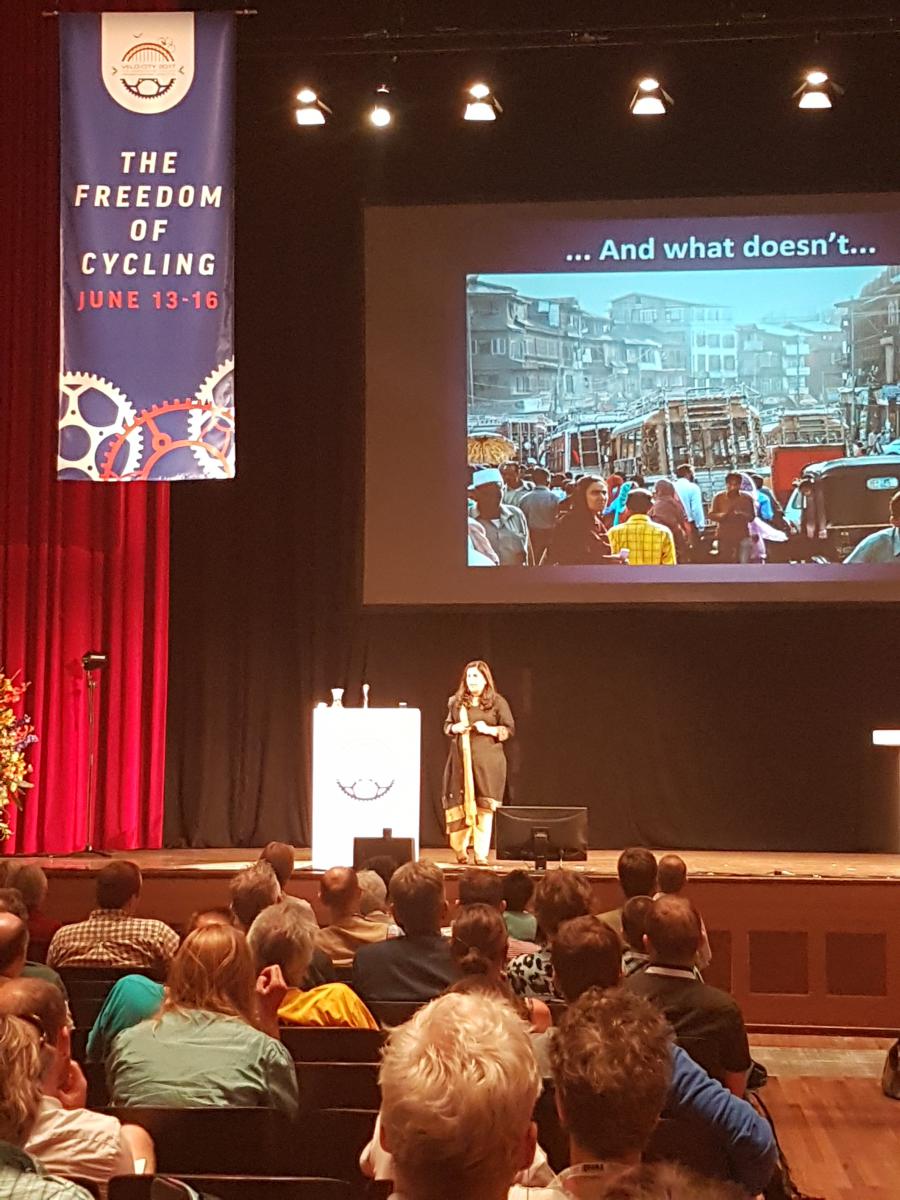 Masi Mohammadi. Head of the research group ‘Architecture in Health’ at HAN University of applied sciences. She also holds the chair of ‘Smart Architectural Technologies’ at Eindhoven University of Technology, in the Netherlands.
Masi Mohammadi. Head of the research group ‘Architecture in Health’ at HAN University of applied sciences. She also holds the chair of ‘Smart Architectural Technologies’ at Eindhoven University of Technology, in the Netherlands.- Pier Eringa (ProRail) and Roger van Boxtel (NS). Manager of the Dutch rail infrastructure and operator companies.
- Shipra Narang Suri - Vice-President of the International Society of City and Regional Planners (ISOCARP)
Moderated by Conny Czymoch, the speakers highlighted the importance of sustainable and accessible housing and urban planning on a local level; showing the relevance of integrated design of urban areas and mass transportation on a national level; and the influence urban planning can have on people’s lives on a global level – focusing on the developing world.
The first speaker, Masi Mohammadi, head of the research group ‘Architecture in Health’ at HAN University of applied sciences, positioned architectural design as a tool to empower citizens. Historically, architecture has been an important instrument of power and wonder. Ms. Narang highlighted how the environment we shape also shapes us, as well as the power of technology to support social activities that change our way of thinking.
Pier Eringa (ProRail) and Roger van Boxtel (NS) are the managers of the national Dutch rail infrastructure and train operations respectively. The experience of the Netherlands shows that ‘bike and train’ are a great combination. The Netherlands is a well-known small country that is very big on something: cycling. With over 1.5 bicycles per inhabitant and 5,000 trains, over half of the 1.2 million daily train passengers access the train station by bike. Furthermore, Dutch trains are now 100% powered by wind energy.

On the other hand, the Netherlands is also a car country. Dutch people drive 6 times more kilometers than they cycle annualy, and the Netherlands is becoming one enormous traffic jam. Action is needed because congestion is bad for the country’s competitiveness, quality of life and environment. Both speakers agreed that there is still plenty of potential for the growth of cycling and public transport and the need for involvement of national governments in cycling investments.
Shipra Narang Suri confessed to the auditorium that she is not a cyclist anymore, but she was in diferent stages of her life, living in different environments. When she moved to York (UK) she started to cycle but most of her working life was in a very different situation. She realized that what encourages you to cycle is compact land use, slow speed, safer streets, integrated mobility options, infrastructure and effective/responsive local institutions.Ms. Suri mentioned that what does not encourage you to cycle is what we have in most of the world: an absence of planned urbanization. Let’s commit globally for the reemergence of planning and cycling will be unstoppable.
Written by: Jesus Freire, Business Development Officer
Regions:
Network/Project Involved:
Contact the author
Recent news!
Upcoming events
Contact Us
Avenue des Arts, 7-8
Postal address: Rue de la Charité, 22
1210 Brussels, Belgium


